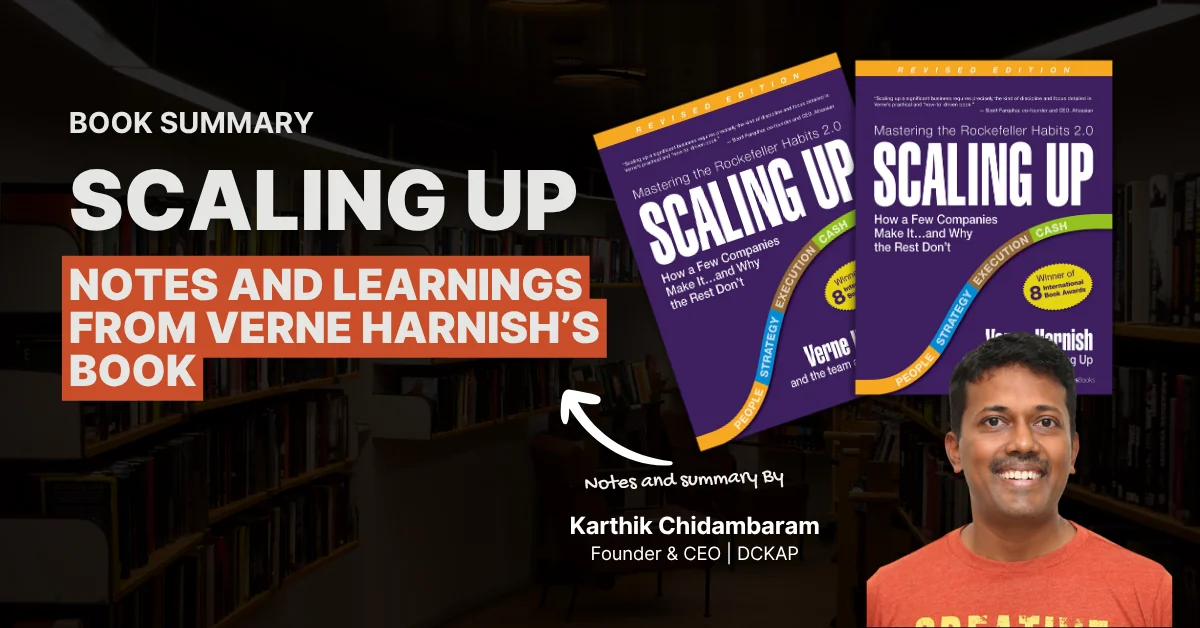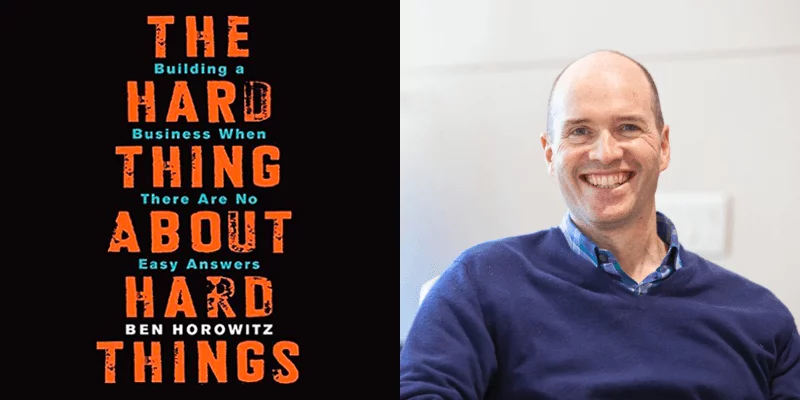Scaling Up – Notes and Learnings from Verne Harnish’s Book
All of us like to scale up our businesses. Recently, I read Scaling Up by Verne Harnish. This book is more like a workbook — it gives you a framework to actually work on your business, not just think about it. Here are some of my notes and learnings from the book.
The Foundation: Never Stop Learning
Harnish emphasizes something fundamental that successful leaders already know — you need to keep reading. He quotes Mark Zuckerberg, whose goal is to read at least two books a month, and Warren Buffett, who dedicates quiet time to reading and thinking. Continuous learning fuels growth.
The Four Keys to Scaling Up
- Attracting and Keeping the Right People
- Creating a Truly Differentiated Strategy
- Driving Flawless Execution
- Having Plenty of Cash to Weather the Storms
Playing the Long Game
Starbucks launched in 1971. It took them 20 years to open their first 100 stores — they used this time to perfect their business model. By their 25th anniversary, they had 1,000 stores. Today, they have over 32,000 stores in 80 countries with more than 383,000 employees.
What if you’ve been running a business for a long time and haven’t scaled yet? Steve Jobs once said, “If you’ve been in business less than 25 years and haven’t scaled up yet, you still have time to make it big. And if it’s more than 25 years — it’s never too late.” He emphasized the long-term game.
Leadership and Focus
The author suggests refocusing the senior team on market-facing activities. When you lead people, repeat yourself over and over again — until everyone gets the message.
The leader’s key job is to keep the main thing the main thing and ensure everyone is headed in the same direction.
Strategy Requires Consistency
Strategic thinking isn’t a once-a-quarter retreat activity. It requires a handful of senior leaders meeting weekly — not quarterly or yearly.
Ask yourself:
- What words do you own in the minds of your customers? (e.g., Google owns “search”)
- What are your three brand promises? (e.g., Southwest Airlines — Low Fares, Lots of Flights, Lots of Fun)
Owning words applies not just to companies but to individuals too. For instance, Tim Ferriss owns the “4-Hour Work Week.”
A good PR strategy matters. Apple’s one-phrase strategy was “closed architecture.” It worked because it was clear and consistent. A company can outperform only if it establishes a difference it can preserve.
Cash is King
Successful companies maintain 10 times more cash assets than their industry average — and they’ve done this from the beginning.
Cash is king. Cashflow is king. You don’t pay bills with profit. Great companies often have 3–10 times more cash than their competitors. Cash isn’t just about survival — it’s about opportunity.
Real-World Transformation: Rudy’s Story
Rudy was running an answering service business with thin margins and high churn. One customer said, “Forget buck per minute — I’ll pay you $25 to take over my calendar and book appointments.”
That lightbulb moment changed everything. Rudy shifted to an outcome-based model, charged a premium, fired low-value customers, and made more revenue with fewer people. His team held daily huddles at 7:30 AM focused on execution and customer interaction.
The lesson: clarity, focus, and frequency matter. Use a One Page Strategic Plan — pinpoint what each person or team needs to accomplish.
The Brutal Truth: The Rehire Question
Here’s a painful but necessary exercise — for everyone on your team, ask:
“Knowing what I know now, would I rehire this person?”
It’s tough because loyalties, egos, and friendships get in the way, but when a company outgrows its leaders, these questions become essential.
Accountability, Responsibility, and Authority
Understanding these distinctions is crucial:
- Accountability: Tracking progress of work
- Responsibility: Supporting the team and executing tasks
- Authority: Final decision-making power
If multiple people are responsible for the same thing — fix it. Create a Functional Accountability Chart — a one-page document showing who owns what.
Building High-Performance Teams: Lessons from Lean Manufacturing and Google
The principles that revolutionized Toyota’s manufacturing can transform any business — including services. Lean isn’t about cutting jobs, but reducing waste and driving clarity.
Clear Accountability: One Person, One Function
Efficiency breaks down when multiple people share responsibility for the same function. Clarity accelerates execution.
Coaching, Not Managing
The best organizations don’t have managers — they have coaches. Coaches develop talent, remove obstacles, and help people perform at their best.
The Art of Strategic Hiring
Finding great talent starts with making yourself visible. As Google learned, “It’s easier to find what you’re looking for if it comes looking for you.”
Write blogs, publish regularly, and stay visible on LinkedIn — become a talent magnet.
Be generous with referral bonuses ($5,000 instead of $500). You need at least 20 qualified applicants per position. And remember — you want “strange” people. Diverse thinkers who bring new perspectives.
Finding Your Talent “Fishing Holes”
Michael Dell famously recruited laid-off Kodak employees and later turned to MIT Sloan for leadership talent. Identify where your ideal candidates naturally gather and recruit from there.
Interviews That Reveal Character
Beyond skills, look for drive and independence. Ask questions like:
- “Did you pay for your own stuff as a teenager?”
- “What companies do you admire?”
These reveal work ethic and values.
Building Balanced Teams
Teams should be well-rounded — individuals don’t have to be. Avoid pairing A-players with B/C-players. It drains energy and slows growth.
The Contract-to-Hire Advantage
Let people work with you for a few weeks before hiring. It benefits both sides and reduces hiring mistakes.
Creating Raving Fans from Day One
Exceptional onboarding builds lasting loyalty. Have senior leaders spend time with new hires. Take them out, know their families, even sponsor a 3-day weekend. Small gestures create raving fans.
Retention Through Recognition
Once you hire well, keep them — pay well, appreciate, and help them play to their strengths. Create custom compensation packages if needed. Never demotivate your best people.
Core Purpose and Differentiation
Your company’s core purpose should be clear — that’s your differentiation.
Core competencies should:
- Be hard for competitors to imitate
- Be reusable across products or markets
- Add direct value to the customer experience
The CEO’s key jobs:
- Set and drive strategy
- Stay close to customers
- Identify trends
Form a Strategy Council (3–5 people) that meets weekly. Constant refinement beats occasional planning.
The One Page Strategy Document
Capture the essentials:
- Core Values
- Purpose
- Brand Promise
- BHAG (Big Hairy Audacious Goal)
Collect regular feedback from employees and customers —
“What should we start doing, stop doing, and keep doing?”
Keep this alive weekly.
Rockefeller Habits Checklist
- The executive team is healthy and aligned.
- Everyone knows the #1 priority this quarter.
- Communication rhythm is established.
- Each area has a person accountable for results.
- Employee input is collected.
- Customer feedback is analyzed frequently.
- Core Values and Purpose are alive in the organization.
- Employees can articulate BHAG, Core Values, and Brand Promises.
- Everyone can quantify whether they had a good day or week.
- The company’s plan and performance are visible to all.
Checklists drive relentless repeatability — a key ingredient in scaling up.
Lifeline Exercise
List your top 5 high and low points in life (excluding marriage or children) and note the age each occurred. This helps you see patterns in your personal and professional growth.
SMART Goals
Goals should be:
Specific, Measurable, Achievable, Relevant, and Time-bound.
In quarterly or monthly meetings, start with celebration — ask:
- What worked?
- Why did it work?
Then dig deeper: Which customer? Who was involved? What problem was solved?
Conversations with Customers
Ask these four powerful questions:
- How are you doing?
- What’s going on in your industry or neighborhood?
- What do you hear about our competitors?
- How are we doing?
Meetings and Cadence
Have daily or regular cadence meetings with key members. In great companies, CEOs’ calendars are planned 200+ days in advance. Jack Welch’s GE scheduled a year ahead.
Frequent communication matters — write weekly notes, record voice updates, and stay connected.
My Take on the book
Thankful to have read this book. There are practical takeaways for each one of us which we can begin to implement or refine. Greatness is not luck — it’s the result of conscious choice and discipline. Scaling up isn’t about doing everything; it’s about doing the right things, repeatedly and relentlessly. I also liked that the author gives clear next steps to put these ideas into action:
- Have your leadership team and employees read or listen to the book.
- Form a weekly council.
- Launch a quarterly theme.
- Start a daily huddle.
- Plan your quarterly or annual offsite — ideally with a coach.
Thank you for reading.




October 30, 2025
Rajesh Kumar Parida
Hi Karthik,
Thanks for sharing the brief about this book. Your post on LinkedIn was so magnetic that it compelled me to come here and read more about it — and I’m glad I did. I’ll definitely get the book and read it in my own way.
One of the key takeaways that will stay with me from your note is “relentless repeatability” and how interviews reveal character.
Thanks a ton for sharing your insights and reflections on this book.
Thanks
Rajesh